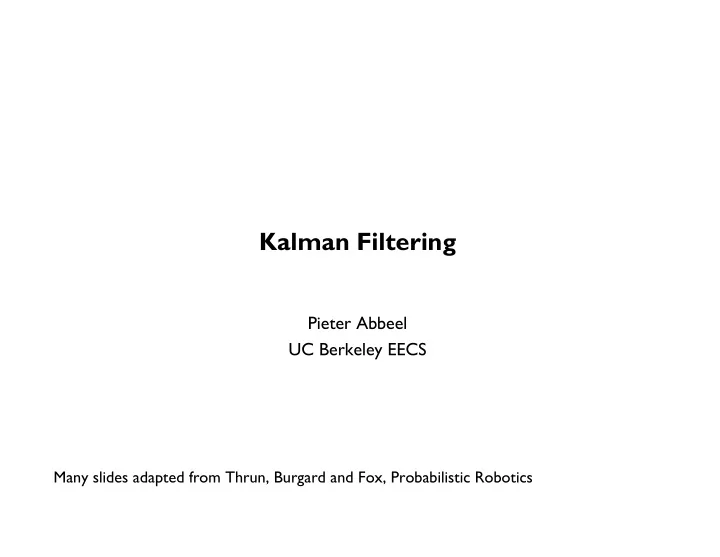

Kalman Filtering Pieter Abbeel UC Berkeley EECS Many slides adapted from Thrun, Burgard and Fox, Probabilistic Robotics
Overview Kalman Filter = special case of a Bayes’ filter with dynamics model and n sensory model being linear Gaussian: 2 -1 Above can also be written as follows: n Note: I switched time indexing on u to be in line with typical control community conventions (which is different from the probabilistic robotics book).
Time update Assume we have current belief for : n X t X t+1 Then, after one time step passes: n
Time Update: Finding the joint n Now we can choose to continue by either of n (i) mold it into a standard multivariate Gaussian format so we can read of the joint distribution’s mean and covariance n (ii) observe this is a quadratic form in x_{t} and x_{t+1} in the exponent; the exponent is the only place they appear; hence we know this is a multivariate Gaussian. We directly compute its mean and covariance. [usually simpler!]
Time Update: Finding the joint n We follow (ii) and find the means and covariance matrices in [Exercise: Try to prove each of these without referring to this slide!]
Time Update Recap X t X t+1 Assume we have n Then we have n Marginalizing the joint, we immediately get n
Generality! V W Assume we have n Then we have n Marginalizing the joint, we immediately get n
Observation update X t+1 n Assume we have: Z t+1 n Then: n And, by conditioning on (see lecture slides on Gaussians) we readily get:
Complete Kalman Filtering Algorithm n At time 0: n For t = 1, 2, … n Dynamics update: n Measurement update: n Often written as: (Kalman gain) “innovation”
Kalman Filter Summary n Highly efficient: Polynomial in measurement dimensionality k and state dimensionality n : O(k 2.376 + n 2 ) n Optimal for linear Gaussian systems! 10
Forthcoming Extensions Nonlinear systems n n Extended Kalman Filter, Unscented Kalman Filter Very large systems with sparsity structure n n Sparse Information Filter Very large systems with low-rank structure n n Ensemble Kalman Filter Kalman filtering over SE(3) n How to estimate A t , B t , C t , Q t , R t from data ( z 0:T , u 0:T ) n n EM algorithm How to compute (note the capital “T”) n n Smoothing
Things to be aware of that we won’t cover Square-root Kalman filter --- keeps track of square root of covariance matrices --- n equally fast, numerically more stable (bit more complicated conceptually) If A t = A, Q t = Q, C t = C, R t = R n n If system is “observable” then covariances and Kalman gain will converge to steady-state values for t -> 1 Can take advantage of this: pre-compute them, only track the mean, which is done by n multiplying Kalman gain with “innovation” n System is observable if and only if the following holds true: if there were zero noise you could determine the initial state after a finite number of time steps n Observable if and only if: rank( [ C ; CA ; CA 2 ; CA 3 ; … ; CA n-1 ]) = n n Typically if a system is not observable you will want to add a sensor to make it observable Kalman filter can also be derived as the (recursively computed) least-squares n solutions to a (growing) set of linear equations
Kalman filter property If system is observable (=dual of controllable!) then Kalman filter will n converge to the true state. System is observable iff n O = [C ; CA ; CA 2 ; … ; CA n-1 ] is full column rank (1) Intuition: if no noise, we observe y 0 , y 1 , … and we have that the unknown initial state x 0 satisfies: y 0 = C x 0 y 1 = CA x 0 ... y K = CA K x 0 This system of equations has a unique solution x 0 iff the matrix [C; CA; … CA K ] has full column rank. B/c any power of a matrix higher than n can be written in terms of lower powers of the same matrix, condition (1) is sufficient to check (i.e., the column rank will not grow anymore after having reached K=n-1).
Recommend
More recommend